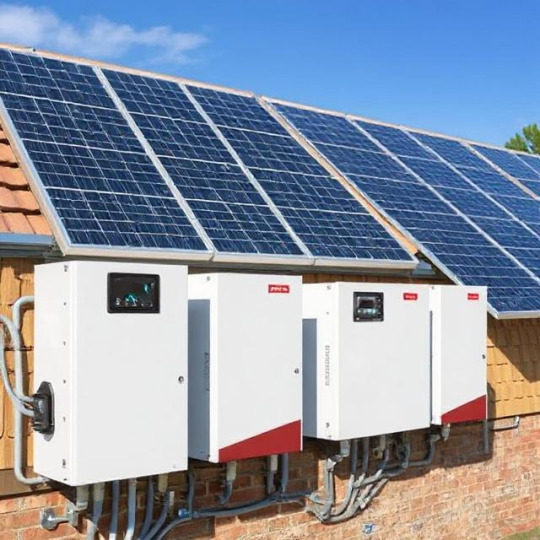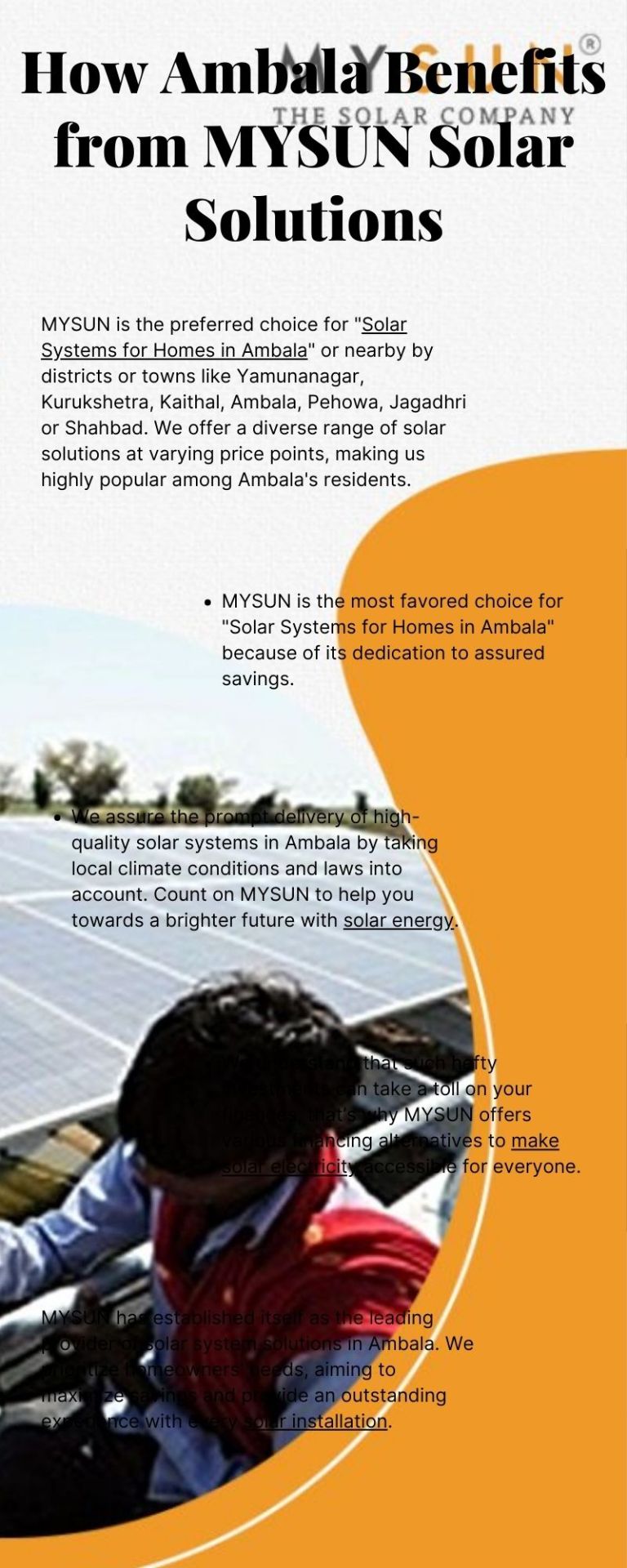#Solar Installations
Explore tagged Tumblr posts
Text
Our Solar Projects & Work Portfolio Bangalore| Ecosoch
Explore Ecosoch’s solar project portfolio featuring residential, commercial, and industrial installations across Bangalore. See how we deliver clean energy through expert solar solutions.

#Ecosoch projects#solar portfolio Bangalore#solar installations#residential solar work#commercial solar projects
0 notes
Text
Top Photovoltaic Inverters for Your Insel Solaranlage 48V!
Looking to enhance your solar energy setup? Check out the outstanding options available in the photovoltaic inverter market, specifically designed for off-grid solar systems.
ECO-WORTHY stands out as a leading brand, offering reliable and efficient inverters that ensure optimal performance for your solar installations. Their products are designed with cutting-edge technology, providing seamless energy conversion and maximum efficiency for your off-grid solar needs.
Whether you're setting up a new system or upgrading an existing one, ECO-WORTHY inverters are an excellent choice, combining durability with user-friendly features. With positive customer feedback and a commitment to quality, you can trust that ECO-WORTHY will effectively power your off-grid solar systems.
Explore the range of ECO-WORTHY photovoltaic inverters today and take a step toward sustainable energy solutions!
#off-grid systems#solar energy#solar installations#durability#user-friendly features#customer feedback#energy conversion#photovoltaic inverters
0 notes
Text
Job Opportunity: Electrician at Manicaland State University of Applied Sciences (MSUAS)! - March 2025
Manicaland State University of Applied Sciences (MSUAS) is seeking a skilled and experienced Electrician to join their Division of Student Affairs, within the Work and Infrastructure Development department! If you are a qualified electrician with a passion for maintaining and improving electrical systems, this is a great opportunity for you. About MSUAS: MSUAS is dedicated to providing a…

View On WordPress
#career#education#Electrical Maintenance#Electrical Power#Electrician Jobs#Hot Zimbabwe Jobs#Infrastructure Jobs#Job Opportunity#jobs#Maintenance Jobs#MSUAS#Mutare Jobs#news#Solar Installations#Technical Jobs#technology#Zimbabwe Jobs
0 notes
Text
Exploring PCU Inverters: Functionality and Benefits for Solar Installations
The globe is transferring towards inexperienced energy, and sun electricity has turned out to be a top choice for clean and green power. If you are making plans to put in a solar strength machine at home or with your employer, you might have heard the time period PCU inverter for solar. But what is it, and the way is it specific from a normal inverter? Knowing the Solar PCU working principle and benefits will help you in making the right choice when putting in your sun machine.

What is a PCU Inverter?
A PCU inverter, or Power Conditioning Unit inverter, is a unique form of inverter that is optimized to make use of maximum sun energy. In comparison to ordinary inverters, which usually use grid electricity and batteries, a PCU inverter manages electricity from sun panels, batteries, and the grid in a smart manner. This maximizes electricity distribution efficiently, minimizing reliance on the grid and electricity payments. A PCU vs normal inverter comparison without problems exhibits that a PCU inverter is a greater shrewd, electricity-saving solution for solar installations.
How Does a PCU Inverter Work?
A Solar PCU inverter optimizes solar energy utilization before utilizing battery strength or the grid. It keeps a steady remark of power consumption and availability and ensures that power generated with the aid of solar energy is well stored and utilized. The inverter offers greater significance to solar power, charging the battery on the same time at the same time as at once utilising it to energise appliances during the day. If solar energy is insufficient, it transitions without difficulty to grid or battery strength. Such a hybrid PCU inverter for solar power application makes it the most sought-after solution for houses and agencies that need seamless electricity delivery with little or no dependency on the grid.
Advantages of PCU Inverters
Purchasing a PCU inverter for solar has diverse advantages. One of the most critical Solar PCU inverter benefits is its electricity to cut down power bills by means of optimizing solar strength utilization. The sophisticated strength management gadget ensures uninterrupted energy delivery with the aid of switching smartly from sun, battery, and grid strength. These inverters also are extremely green, maximizing power output with minimal loss all through conversion. In addition, they prolong the lifestyles of batteries by keeping off useless deep discharging. This renders PCU inverters a price-powerful and environmentally pleasant solution for solar electricity customers.
Off-Grid vs On-Grid PCU Inverter
The choice between an off-grid vs on-grid PCU inverter is based on your strength necessities and geographical region. An off-grid PCU inverter is appropriate for places with poor grid electricity or no grid delivery, as it accumulates surplus sun electricity in batteries to use later. This provides a regular energy supply even all through the night or on overcast days. Conversely, an on-grid PCU inverter is plugged into the grid, permitting customers to supply extra sun strength returned to the software organisation, cutting down the energy bill in addition. Hybrid PCU inverters offer a mix of each, giving customers freedom in electricity management.
Choosing the Right PCU Inverter for Solar Panels
Choosing the best PCU inverter for home use involves thinking about quite a number of things consisting of electricity capability, performance, and compatibility along with your solar panel installation. Efficient inverters suggest greater of the generated sun energy is changed into energy, subsequently minimizing wastage. Looking up PCU inverter price comparison among various manufacturers facilitates one to determine an low priced however efficient unit. It is also essential to select an inverter with robust protection features inclusive of overload and quick-circuit safety to assure protection and sturdiness.
PCU Inverter Efficiency in Solar Systems
The efficiency of any sun set up is certainly one of its most crucial factors. PCU inverter efficiency in solar systems is lots more than that of traditional inverters due to the smart law of energy distribution by using the previous. These inverters make sure that solar electricity is the dominant supply of power, resulting in decreased power loss and advanced system overall performance. Higher end models even possess MPPT (Maximum Power Point Tracking) technology, which raises efficiency even more via maximizing sun panel strength output.
Solar PCU Inverter Installation Guide
Correct installation is vital to obtain the gold standard performance of a Solar PCU inverter. The inverter ought to be set up in a ventilated location, no longer without delay exposed to sunlight and moisture, to avoid overheating and damage. It is suggested that the installation be carried out by means of an expert to ensure right electrical connections are made and to fulfill safety requirements. A great Solar PCU inverter installation guide may also have steps on a way to installation settings for efficient energy management in step with character power necessities.
PCU Inverter Maintenance Tips
Routine preservation will increase the lifespan and performance of a PCU inverter for solar. Ensuring the inverter is smooth and dirt-unfastened enhances cooling and avoids overheating. Periodic checking of the battery connections ensures a stable electricity supply, and updating the firmware, if available, enhances overall performance. Monitoring the electricity output thru the display of the inverter or mobile app can also help in detecting any performance problems at an early stage and taking corrective measures.
The Future of PCU Inverters in Solar Power
As the growth in solar strength use will increase, Hybrid PCU inverters for solar power have become popular by the way of the day. Advancing technology leads to more modern models having extra efficiency, real-time observation, and clever control structures. The amenity of using PCU inverters to synchronize grid and off-grid structures positions them because the prized asset to be blanketed inside every solar power configuration.
Final Thoughts
If you want an energy-saving and price-powerful answer on your sun electricity gadget, a PCU inverter for sun is the right investment. The inverters store energy, decrease the usage of grid electricity, and increase the life of the battery. Be it an off-grid or on-grid PCU inverter, selecting the perfect version depending on your energy wishes will offer you a trouble-free and non-stop energy supply. With the proper installation and preservation, a Solar PCU inverter can provide smooth and sustainable electricity for many years to come.
0 notes
Text
Explore how solar installations are shaping a greener future by reducing energy costs, cutting emissions, and promoting sustainability. Discover how SunGarner is making clean energy accessible for everyone. https://www.sungarner.com/blogs/home/details/how-solar-installation-is-shaping-a-sustainable-future
0 notes
Text

Discover why solar energy is essential for a sustainable future in this insightful blog. Learn how it reduces reliance on fossil fuels, lowers carbon emissions, and cuts energy costs. Explore the environmental and economic benefits of solar power, making it a critical solution for addressing climate change and achieving energy independence. Perfect for eco-conscious individuals and businesses!
#Use Of Solar Energy#Solar Energy Important#Solar Energy#Installing Solar Energy#Solar Installations
0 notes
Text
Why Solar Roofing Companies are the Future of Energy
Solar roofing companies are revolutionizing the energy industry. Here’s why:
Sustainable Energy: Solar power is a clean and renewable energy source, reducing our reliance on fossil fuels and lowering carbon emissions.
Cost Savings: Over time, solar panels significantly reduce electricity bills, making them a smart long-term investment for homeowners and businesses.
Increased Property Value: Homes with solar installations are more attractive to buyers, often selling at higher prices.
Government Incentives: Many governments offer tax credits and incentives for installing solar panels, making it more affordable.
As the world shifts towards sustainable living, solar roofing companies like Best Roof And Solar are leading the charge, providing innovative solutions that benefit both the environment and your wallet. Choose solar roofing today and be part of the energy future.
0 notes
Text
Renewable Energy Potential: Mapping India's Transition to a Green Future

India stands at a crucial juncture in its quest for sustainable development, marked by a significant shift towards renewable energy sources. With the pressing need to mitigate climate change and reduce dependence on fossil fuels, the country is increasingly turning to solar energy and other renewables to power its future. This transition is not merely about embracing cleaner sources of energy; it represents a fundamental restructuring of India's energy landscape, with far-reaching implications for its economy, environment, and society.
Embracing Solar Power:
Solar energy has emerged as a cornerstone of India's renewable energy strategy. Blessed with abundant sunlight throughout the year, India possesses immense solar energy potential, making it an ideal candidate for large-scale solar power generation. The government's ambitious targets, such as achieving 100 GW of solar capacity by 2022 and 450 GW by 2030, underscore its commitment to harnessing this abundant resource.
One of the most notable successes in India's solar journey has been the dramatic reduction in solar tariffs. Through competitive bidding processes and technological advancements, the cost of solar power has plummeted, making it increasingly competitive with conventional sources of energy. This cost competitiveness has not only accelerated the deployment of solar projects but has also made solar energy accessible to a wider range of consumers, including industries, commercial establishments, and households.
Beyond Solar: Diversifying the Renewable Portfolio:
While solar energy dominates discussions around India's renewable energy transition, other sources such as wind, hydro, biomass, and geothermal also play crucial roles. Wind energy, in particular, has witnessed significant growth, with India emerging as one of the world's top wind energy producers. Similarly, the untapped potential of hydroelectric power, particularly in regions like the Himalayas, presents opportunities for further expansion.
Moreover, advancements in technology and innovation are opening up new frontiers in renewable energy. From offshore wind farms to floating solar installations and innovations in energy storage, these developments are enriching India's renewable energy portfolio and enhancing its resilience against variability in weather conditions.
Policy Support and Regulatory Framework:
The success of India's energy transition hinges upon a conducive policy environment and robust regulatory frameworks. The government's flagship initiatives, such as the National Solar Mission, the Green Energy Corridor Project, and various state-level policies, provide the necessary impetus for renewable energy deployment. Furthermore, measures such as renewable purchase obligations, net metering, and fiscal incentives are incentivizing investments in clean energy projects.
However, challenges persist, including land acquisition issues, grid integration constraints, and financing hurdles. Addressing these challenges requires a coordinated effort from policymakers, industry stakeholders, and civil society to streamline processes, enhance grid infrastructure, and mobilize investments.
Socioeconomic Impacts and Opportunities:
India's transition to renewable energy is not only about reducing carbon emissions; it also holds immense socioeconomic potential. The renewable energy sector is a significant driver of job creation, offering employment opportunities across the value chain, from manufacturing and installation to operations and maintenance. Moreover, decentralized renewable energy solutions have the potential to empower rural communities by providing access to clean, reliable, and affordable energy.
Furthermore, by reducing dependence on imported fossil fuels, India's renewable energy push enhances energy security and reduces the nation's vulnerability to global energy price fluctuations. This, in turn, strengthens India's economic resilience and fosters sustainable growth.
Conclusion:
India's journey towards a green future powered by renewable energy is both promising and challenging. While significant progress has been made, much work lies ahead to realize the full potential of renewables and achieve the nation's energy transition goals. Collaboration among government, industry, academia, and civil society will be key to overcoming barriers, driving innovation, and accelerating the adoption of clean energy technologies. With steadfast commitment and collective action, India can pave the way for a sustainable, inclusive, and prosperous future powered by renewable energy.
0 notes
Text
0 notes
Text

How Ambala Benefits from MYSUN Solar Solutions
MYSUN Solar Solutions is the leading solar company in Ambala, providing sustainable and cost-effective solar solutions for homes and businesses. Discover how Ambala benefits from our solar solutions today!
#Solar Systems for Homes in Ambala#Solar Systems for Homes#solar power#solar installations#solar install in Ambala#solar system in Ambala#solar system solutions#solar energy#make solar electricity#MYSUN
0 notes
Text
our trusted partners | eco soch
Meet EcoSoch’s trusted partners who help us deliver high-quality solar rooftop systems and sustainable energy solutions across Bengaluru, India.

0 notes
Text

Roof of my car froze after it rained today
#it’s like Damascus steel#free plug for this dudes solar installation service ig#I think I’m going to get some mileage out of it as a photoshop asset
92 notes
·
View notes
Text
On the outskirts of Oslo, just beyond the point where the city dissolves into forest, one thousand spruce saplings reach feathery green fingers toward the sky. Just over ten years ago this clearing was just another part of Norway’s vast woodlands. Today these trees are destined to become part of a unique library of texts by beloved authors, a century in the making.

Top: A crowd assembles for Valeria Luiselli’s handover ceremony in a spruce forest in Oslo in 2024. Luiselli was the tenth author to contribute to the Future Library. Bottom: The Silent Room, situated on the top floor of a public library in Oslo, contains one hundred drawers built into the walls where the authors’ manuscripts are preserved. (Credit: Vilma Taubo, Einar Aslaksen)
The spruces were planted in 2014 as part of the Future Library, a one-hundred-year art project by Scottish artist Katie Paterson. Every year a different author is invited to write a new piece that will be held, secret and unread, until 2114, when all the works will be published using paper made from the spruces’ then-mature wood. The inspiration for the piece arrived for Paterson during a train journey when she had a sudden vision of trees whose rings held words. Though the particulars evolved, the original idea remains, she says, of “trees being books, books being trees, and libraries being forests in the making.”
At the first handover ceremony, during which inaugural contributor Margaret Atwood presented her manuscript among the saplings, the trees were so small that staff decorated them with red ribbons to prevent attendees from trampling them. Now the trees are gawky adolescents, their ribbons decorative rather than practical—a testament to the project’s first decade and time’s insistent trudge. The Future Library continues to inspire imagination and instill new ideas in writers and readers alike through its abiding belief in a future full of stories.
Some sixteen thousand pieces of wood from trees cut down to make space for the spruce saplings were incorporated into the Silent Room, a chapel-like venue that opened in 2022 in a public library in Oslo, where all one hundred texts will be entombed until 2114. The chamber was designed with longevity in mind, using ultra-simple construction methods and specialty lighting. It is also beautiful: warm, wooden, and womblike, big enough for a few people at a time to sit in shoeless contemplation, just a few feet from manuscripts they will never read.
The chair of the Future Library Trust, Anne Beate Hovind, helped spearhead construction of the Silent Room; she is also the original commissioner of the work, part of a public art initiative connected to the redevelopment of Oslo’s waterfront. Over the years, she has also identified land for the saplings, overseen their planting, and negotiated a century-long contract that ensures their protection and maintenance by municipal foresters. Thus far ten authors from across the globe, including 2024 Nobel Prize winner Han Kang and Zimbabwean novelist Tsitsi Dangarembga, have deposited manuscripts there. (This year’s contributor, Tommy Orange, will hand over his manuscript in the summer.) They are invited to do so and paid a flat fee, by a surprisingly small team—including Hovind, Paterson, and the leaders of the city library and three publishing houses. The goal is for the collection of works “to be read as a global project,” Hovind says, so the group works together to generate a long list of candidates, incorporating nominations from interested embassies and past contributors, before coming to a consensus.
For the Icelandic writer Sjòn, who goes by a mononym, the project represents an exquisite metaphor for literature itself—a tradition that binds human beings together across generations. Through literature, he says, “I can have a conversation with someone who has left traces of [themself] three thousand years ago in a poem,” and participating would allow him to engage similarly with future readers.
Still, he found deciding what to write almost impossibly daunting, as did 2022 contributor Judith Schalansky. She obsessed over her contribution, reading the requirements over and over—she even considered submitting hardcore textual pornography as a commentary on the immense possibilities of a no-questions-asked publishing guarantee. In the end, both she and Sjòn took inspiration from the way today’s century-old texts illuminate their era to shape their contributions.
Both authors also found the secrecy to be a particular challenge. “I realized how much I write for the present,” Schalansky says. Meanwhile Sjòn, who had previously believed he wrote solely for himself, was surprised to find the process deeply lonely without the possibility of feedback.
The project’s annual handover ceremonies have become important waypoints marking the library’s age and progress. Each ritual is unique and open to the public: Ocean Vuong’s featured chants by Buddhist monks; Karl Ove Knausgård’s, a recitation of an ancient Norwegian poem; Sjòn’s, a song performed by his wife, with harp accompaniment.
Afterward, walking among the spruces, Sjòn was keenly aware that he was following the same path, quite literally, as writers before and after him, shared custodians of a sacred, multi-millennial storytelling tradition. Much of the work of the Future Library engenders this kind of deep mutual trust across time, Hovind says, in the trustees who will come after her; in the longevity of the rituals and mechanisms she and Paterson have spent years putting into place; in the human beings who will receive the books in an unknown world. That means fighting the impulse to solve or predict every technological, societal, or ecological eventuality of the next ninety years. Paterson adds: “I think taking it decade by decade is all we can do.”
It will be up to future trustees to figure out how to make spruce trees into paper or where to print the books. And, Hovind wonders, what if the forest around the library saplings is developed? How will the trees fare as temperatures rise?
At the project’s start the climate crisis was looming, Paterson says, but its rapid intensification has changed how people engage with the library today. In 2014, she and Hovind were frequently asked if they thought there would still be books in one hundred years. Now in contrast, she observes, “It has turned to, ‘Will there be people?’” In the face of the doom and doubt of the contemporary zeitgeist, the project has become a source of optimism that contributing authors cite year after year, moved by its certainty that we can still build a literary future.
This hope is not without complexity—after all, the Silent Room was built with trees sacrificed to the cause, and more will fall in ninety years—but it sends a powerful message nonetheless. The Future Library prompts its audience to consider the “good ancestor perspective, how to take future generations into consideration now,” Hovind says, while insisting on the immortality and influence of storytelling: “If you can imagine futures, with strong narratives, you can also create them.”
Alissa Greenberg is an independent journalist based in Boston and Berkeley, California, who reports at the intersection of science, history, and culture. Her work has appeared in the Atlantic, the San Francisco Chronicle, the Washington Post, the New Yorker, and elsewhere.
#poets and writers magazine#article#library#norway#books and libraries#books and literature#trees#solar punk#climate crisis#the future#conservation#art#art project#art installation
11 notes
·
View notes
Text


i'm doing my part!
#we installed some solar panels about a year ago#one of the best investment we've ever made#not just for us financially and in terms of standard of living (we use more power than ever but pay less than ever)#but also for the environment!#win-win!
3 notes
·
View notes
Text

Solar energy is key to building a sustainable future. This blog highlights top reasons why solar power is essential, from reducing carbon emissions to lowering dependence on fossil fuels. Learn how solar energy promotes cleaner air, cuts energy costs, and supports eco-friendly living, empowering communities to embrace a greener planet for generations to come.
#Solar Power#Solar Energy#Solar Energy Systems#Installed Solar Energy#Investing in Solar Energy#Investing in Solar#Solar Panels#Solar Installations#Cost of Solar Installations
0 notes